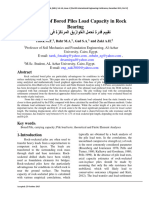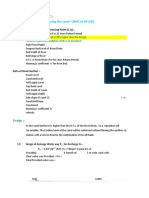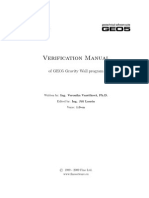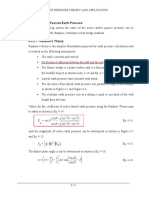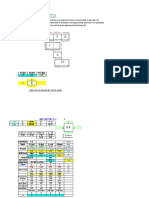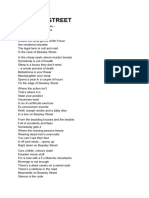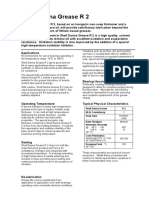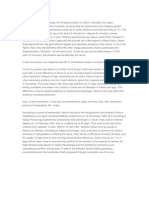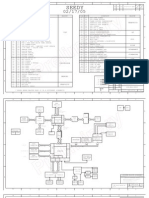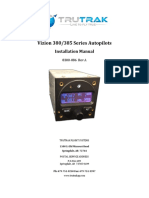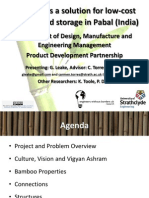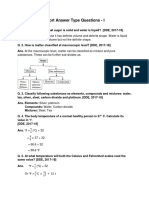Olompia Underpass
Olompia Underpass
Uploaded by
Engineeri TadiyosCopyright:
Available Formats
Olompia Underpass
Olompia Underpass
Uploaded by
Engineeri TadiyosOriginal Description:
Copyright
Available Formats
Share this document
Did you find this document useful?
Is this content inappropriate?
Copyright:
Available Formats
Olompia Underpass
Olompia Underpass
Uploaded by
Engineeri TadiyosCopyright:
Available Formats
Addis Ababa City Roads Authority
SUB-SURFACE INVESTIGATION
AND FOUNDATION
RECOMMENDATION REPORT
FOR
Bole-Meskel Square Road
(At Olympia Traffic Light Junction)
JUNE 2008
P.O.BOX 62668 Tel. 391065/391733/391617/395955/391499 Fax 391230, 391617
E-mail: sava.eng@telecom.net.et/saba,eng@telecom.net.et
Addis Ababa, Ethiopia
Addis Ababa City Roads Authority
Bole-Meskel Square Road, Olympia Traffic Light Junction
TABLE OF CONTENTS
Page
1. INTRODUCTION .................................................................. 1
1.1 Background .................................................................................... 1
1.2 Location .......................................................................................... 1
1.3 Regional and Site Geology.............................................................. 1
1.3.1 Regional Geology ..................................................... 1
1.3.2 Site Geology............................................................. 2
2. METHODOLOGY .................................................................. 3
2.1 Drilling ............................................................................................ 3
2.2 Testing and Sampling..................................................................... 3
1.2.1 Field Testing ............................................................ 3
2.2.2 Sampling ................................................................. 3
3. GEOTECHNICAL CHARACTERISTICS................................... 5
4. FOUNDATION RECOMMENDATION ...................................... 6
5. CONCLUSION .................................................................... 12
APPENDICES
Appendix 1: Borehole Logs
Appendix 2: Borehole Locations
Appendix 3: Geological Cross Section
Appendix 4: Laboratory Test Results
Appendix 5: Core Boxes Photograph
Geotechnical Investigation and Foundation Recommendation Report
SABA Engineering Plc.
Addis Ababa City Roads Authority
Bole-Meskel Square Road, Olympia Traffic Light Junction
1. INTRODUCTION
1.1 Background
As per the request made by the client (i.e. Eng. Zewdie Eskinder & Co. Plc) for
Geotechnical Investigation and Foundation Recommendation works for Bole Ring
Road Round About to Meskel Square Road Design and supervision, SABA
Engineering PLC has executed a geotechnical investigation work by drilling four
exploratory boreholes to a maximum depth of 15.00 m at Olympia Junction at the
proposed locations shown on the attached site plan (Appendix 2).
The objective of this investigation was to:
• Determine the type and extent of geological formations;
• Investigate the presence of ground water and identification of its level if
encountered;
• Determine the engineering properties of the layers constituting the sub-
surface geology of the site.
The field investigation was conducted from June 01 to June 06, 2008.
Accordingly, the general and particular geology of the site and the methodologies
employed are described and the investigation and tests used to study the engineering
properties of the sub-surface strata including analysis and interpretations of results are
discussed. Finally, recommendation is given with regard to the bearing layer, bearing
depth, allowable bearing pressure and suitable type of foundation.
1.2 Location
The new circular overpass structure is located at Olympia area having four supporting
piers. At each pier one borehole was drilled to various depths below NGL till a
confidential bearing layer was identified. The coordinates and elevations fo boreholes
measured using hand-held GPS and the depths drilled are tabulated as follows:
Borehole Easting Northing Elevation Depth
(m)
BH-A 0474428 0995147 2347 11.90
BH-B 0474400 0995131 2347 12.10
BH-C 0474446 0995106 2347 10.10
BH-D O474423 0995090 2345 15.00
1.3 Regional and Site Geology
1.3.1 Regional Geology
Addis Ababa city is situated in the western margin of the Main Ethiopian Rift and
represents a transition zone between the Ethiopian Plateau and the rift with poorly
defined escarpment.
The geology of Addis Ababa area is represented by four volcanic units dominated in
the lower part by basaltic lava flows (Addis Ababa basalt), followed by a pyroclastic
sequence, mainly formed by ignimbrites (Addis Ababa Ignimbrite), followed by
Geotechnical Investigation and Foundation Recommendation Report 1
SABA Engineering Plc.
Addis Ababa City Roads Authority
Bole-Meskel Square Road, Olympia Traffic Light Junction
central composite volcanoes (Central Volcanoes unit), and finally small spatter cones
and lava flows (Akaki unit).
Addis Ababa basalt extensively crops out along Akaki, Kebena, and Dukem rivers at
the east to southeastern part of Addis Ababa, and represents the oldest unit of the
area.
It consists of essentially sub-horizontal lava flows with thickness ranging from few
meters up to 20m. Maximum exposed thickness was found east of Addis Ababa,
along the Kebena River. Addis Ababa basalt is predominantly constituted by alkaline
and olivine basalts with three main textural attributes, that is, porphyritic, aphyric,
and sub-aphyric.
Addis Ababa ignimbrite is exposed close to Addis Ababa along the Akaki and
Kebena rivers. It overlies the Addis Ababa basalt and locally covers the products of
the composite central volcanoes of Wechecha and Furi. The sequence is constituted
by different flow units, consisting of pale-green to pale-yellow welded and crystal
rich ignimbrites.
Central volcanoes unit includes the Yerer volcano and the product of the two
composite volcanoes Wechecha and Furi west and southeast of Addis Ababa,
respectively. Wechecha and Furi volcanoes are two large edifices composed by
predominant trachyte with minor pyroclastics. Yerer represents the largest volcanic
edifice in the region, with a relief of 1000m from the plain and 14km wide along east-
west direction. Products mainly consist of trachytes, even if pyroclastics are
widespread mainly in the central part eastern sector. The highest part of Yerer
volcano was affected by a more recent volcanic activity that produces spatter cones
and associated basalt.
Akaki unit crops out east of Addis Ababa and consists of scoria and spatter cones
with associated tabular lava flows and phreato-magmatic deposits. Alluvial deposits
covering these units consists of regolith, reddish brown soils, talus and alluvium with
maximum thickness of about two meters.
1.3.2 Site Geology
Below the relatively thin layer of back-fill material, the entire project site is underlain
by residual soil layer comprising stiff, brown to light yellowish sandy silty
clay/clayey silt occasionally mixed with some highly weathered gravel-sized basalt
fragments.
The detailed geological strata encountered are presented in the boreholes log sheets
attached with this report (Appendix 1).
Geotechnical Investigation and Foundation Recommendation Report 2
SABA Engineering Plc.
Addis Ababa City Roads Authority
Bole-Meskel Square Road, Olympia Traffic Light Junction
2. METHODOLOGY
Drilling
Rotary core drilling technique has been employed using one Korean made crawler
type drilling rig having the capacity to perform boring operation to the required
standard and quality.
Dry drilling method has been utilized for the top soil formation using inner lining and
double core barrels fitted with appropriate size tungsten carbide bits at the bottom in
order to achieve good quality core recovery. When the formation changed to rock,
water was pumped down to the bit through hollow drill rods, thus, lubricating the bit
and flushing the debris up the borehole.
Telescopic drilling was used whereby the drilling size was reduced progressively
starting from 110 mm hole diameter to 101mm and remained so till the completion
depth.
Ground water was not encountered in all the boreholes till completion depth.
Testing and Sampling
Field Testing
The field testing was conducted in the boreholes starting from a depth of 1.50m
below NGL
Standard penetration tests (SPTs) have been conducted inside boreholes using a
standard hammer, weighting 63.5 kg and falling freely from a height of 760 mm
along a frictionless guide rod in accordance with test procedure mentioned in test No.
19 of BS 1377; 1975. Blow counts for a total penetration depth of 450 mm from the
bottom of a cleaned borehole were recorded and counts for the first 150 mm
penetration were discarded since the ground is considered to be distributed by drilling
activity prior to the test. SPT N-values for the last 300 mm penetration were thus
recorded at the corresponding depths on the borehole log sheets.
Sampling
Two undisturbed soil samples were taken using thin wall Shelby tube from boreholes
BH-C (at a depth of 3.60m) and BH-D (at a depth of 6.0m) for soil UCS and direct
shear tests. Additionally, eleven distributed soil samples were taken from SPT split -
spoon sampler from the boreholes (as shown on the borehole log sheets) for
laboratory determinations of gradation, Atterberg limit and free swell tests.
Table (2-1) presents summary of the exploration methods and tests performed for the
project.
Core samples recovered from core barrels were arranged in partitioned wooden core
boxes having 1.0 m length, and are properly labeled indicating project name, client,
borehole designation, depth, etc. The cores inside core boxes were logged and
photographed (colored) as part of the report document.
Geotechnical Investigation and Foundation Recommendation Report 3
SABA Engineering Plc.
Addis Ababa City Roads Authority
Bole-Meskel Square Road, Olympia Traffic Light Junction
Table 2.1: Summary of Methods of Exploration and Tests Performed for the
Project
Type of Exploration/Test Qty.
− Boreholes to a maximum depth of 15.00 meters 4
− Standard Penetration Tests (SPT) 16
− Undisturbed Sampling 2
− Disturbed Sampling 11
− Laboratory Tests
Gradation 11
Atterberg Limits 11
Free Swell 11
Direct Shear 2
UCS of soil 2
Geotechnical Investigation and Foundation Recommendation Report 4
SABA Engineering Plc.
Addis Ababa City Roads Authority
Bole-Meskel Square Road, Olympia Traffic Light Junction
3. GEOTECHNICAL CHARACTERISTICS
Descriptive analysis was made on the soil samples derived from the boreholes. This
was used together with the classification tests and relative compactions as indicated
from the SPT tests, and the following generalized geo-technical layers are identified.
Details on type and extent of the geothecnical layers are given in Appendix 1 (Borehole
logs).
A. Back-fill material
The top most part of the project site at Olympia junction is composed of a back-fill
material having thicknesses varying from 0.45m around BH-D to 1.90m around BH-B.
B. Dense residual soil layer
Underlying the back-fill material, dense residual soil layer of basalt origin comprising
sandy silty clay/clayey silt mixed with some gravel-sized basalt rock fragments were
found and continued to the bottom depth where drilling terminated.
The field SPT N-values conducted in these layers ranges from 14 to 42 indicating dense
nature of natural compaction down deep the layer. The soil consistency test results for
the residual soil layer showed Plasticity Index and Liquid Limit values varying from
6% to 22% and from 39% to 67% respectively. The free swell is about 10% to 90%.
According to Unified Soil Classification System, the residual soil layer is classified as
low plastic. According to Bowles, 1988, soils having a PI values lower than 35% show
a very low potential for volume change.
Geotechnical Investigation and Foundation Recommendation Report 5
SABA Engineering Plc.
Addis Ababa City Roads Authority
Bole-Meskel Square Road, Olympia Traffic Light Junction
4. FOUNDATION RECOMMENDATION
Foundation recommendation refers to the determination of the bearing layer and depth,
allowable pressure on the bearing layer and type of foundation that could be adopted
safely and economically.
As can be observed from the stratigraphy encountered in all the boreholes, the dense
residual soil layer can be considered for placing foundation footings of the four pier
structures of the overpass. The allowable bearing pressures for the selected foundation
layers shall be discussed based on correlation of the relative compaction of the in-situ
ground as indicated from SPT and laboratory determination of UCS. Determination of
the allowable bearing pressures and selection of foundation types and depth is discussed
below:
Isolated Footing Foundation on residual soil layer
A. Bearing Pressure Based on UCS
UCS tests were conducted on two undisturbed soil samples taken from BH-C at a depth
of 3.60m and BH-D at a depth of 6.0m. The test results are shown below:
Bulk Unit Dry Unit Moisture
BH UCS Cu
Depth (m) Weight Weight Content
No. (kg/cm2) (kg/cm2)
(gm/cc) (gm/cc) (%)
BH-C 3.60-3.85 1.830 1.489 22.93 0.693 0.347
BH-D 6.00-6.30 1.890 1.559 21.23 0.690 0.345
Unconfined compression tests were conducted on two soil samples to derive the
undrained shear strength value, Cu of the soil. The average of Cu values obtained from
BH-C and BH-D is considered and angle of internal friction, Ø is taken as zero.
Ø = 0, UCS = 67.8 kPa, Cu = 33.9 kPa (½ UCS)
The net ultimate bearing pressure for vertical loads on clay soils is normally computed
as a simplification of either the Meyerhof or Hansen equations as follows (Bowles,
1984). For cohesive soils, changes in ground water levels do not affect theoretical
ultimate bearing capacity. Presence of ground water has no effect on cohesive soils with
Ø = 0. For the most critical stability state (Ø = 0), which is created when the foundation
load is applied so rapidly, the immediate bearing capacity is independent of the location
of the water table. This is in contrast to the long term stability in which case the value
of the drained shear strength cd, and the bearing capacity factors are obtained
corresponding to a drained friction angle Ød.
qult = CNcScdc + q(Nq – 1)
When C = su, we have Ø = 0 and Nq = 1.0. In this case we have
qult = CNcScdc (when Ø = 0, Nc = 5.14)
Geotechnical Investigation and Foundation Recommendation Report 6
SABA Engineering Plc.
Addis Ababa City Roads Authority
Bole-Meskel Square Road, Olympia Traffic Light Junction
qult = CNcScdc = 33.9(5.14)(1.2)(1.2) = 250
When designing a foundation on the basis of ultimate bearing capacity, a suitable factor
of safety should be used to determine the allowable pressure so that the foundation
system may be safe against shear failure. For footing foundations, a factor of safety of 2
to 3 is commonly used under normal loading conditions. Thus, taking a factor of safety
of 3; one obtains:
qallowable = 250/3 = 84 kPa
The allowable bearing pressure obtained from the analysis based on soil UCS tests is
very low.
B. Bearing Pressure Based on Direct Shear Test
In order to get the shear strength properties of the silty clay/silt soil, Direct Shear tests
were conducted on undisturbed samples retrieved from the boreholes. The friction angle
(φ), cohesion (C) and unit weight (γ) are obtained from the direct shear tests conducted
on two Shelby tube samples taken from BH-C and BH-D. Since the samples represent a
layer which has more or less similar characteristics we have taken the average values
for φ, C and γ of the upper silty clay/silt soil.
The test results are shown below:
Bulk Unit Dry Unit Moisture
BH φ
Depth (m) Weight Weight Content C (kN/m2)
No. (degree)
(gm/cc) (gm/cc) (%)
BH-C 3.60-3.85 1.814 1.470 23.5 62.67 20.05
BH-D 6.00-6.30 1.869 1.542 21.2 70.33 21.55
Among the bearing capacity equations we have chosen Meyerhof’s bearing capacity
equation since it can be used in any situation. Terzaghi’s bearing capacity equation is
usually preferred for very cohesive soils where D/B < 1.
Allowable Bearing Capacity for a Square Footing Using Meyerhof’s equation:
qult = CNcscdc + qNqsqdq + 0.5γBNγsγdγ
qult = Ultimate Bearing Capacity
qall = Allowable Bearing Capacity
C= Cohesion (66.5 kPa), Average of two values
φ= Friction Angle (20.8°), Average of two values
γ= Unit Weight (18 kN/m3), Average of two values
B= Width of Footing
D= Depth of Footing
sc, sq, sγ = Shape Factors
dc,dq,dγ = Depth Factors
Nc,Nq,Nγ= Bearing Capacity Factors
J.E.Bowels states that the base width term can be ignored for a conservative solution
since its contribution is not substantial. Thus the base width term has been ignored and
Geotechnical Investigation and Foundation Recommendation Report 7
SABA Engineering Plc.
Addis Ababa City Roads Authority
Bole-Meskel Square Road, Olympia Traffic Light Junction
the depth factor dropped since the application of these theoretically based values to a
practical situation has been questionable. (Vesic, 1975).Thus the increased bearing
capacity of shallow footings due to the depth effect has not been taken into account.
Substituting the relevant values in the equation we obtain:
qult = CNcsc + qNqsq
= 66.5 X 15.61X1.4+ (18.0-9.81) X 6.93 X 1.2 = 1800 kPa
qult = 1453 + 68 = 1521 kPa
When designing a foundation on the basis of ultimate bearing capacity, a suitable factor
of safety should be used to determine the allowable pressure so that the foundation
system may be safe against shear failure. For footing foundations, a factor of safety of 2
to 3 is commonly used under normal loading conditions. Thus, taking a factor of safety
of 2.5; one obtains:
qallowable = 1521/3 = 505 kPa
C. Bearing Pressure Based on SPT Values
SPT values were used to calculate the bearing capacity of the residual soil layers.
Representative values are selected from the SPT data. The boreholes, the depths below
NGL at which the selected SPT N- values are obtained, the SPT N-values and the
adjusted N-values (i.e. N’55) are given below and they are considered for determining
the design N-values.
Boreholes Depth (m) SPT N-value Adjusted SPT N-value
BH-A 1.50 14 17
BH-A 3.60 38 29
BH-A 5.60 40 28
BH-A 6.90 42 29
BH-B 1.50 6 7
BH-B 3.00 18 15
BH-B 4.50 24 19
BH-B 6.0 >50 34
BH-C 1.50 26 31
BH-C 3.85 43 32
BH-C 5.80 48 33
BH-C 7.80 >50 33
BH-D 1.50 9 11
BH-D 3.00 20 17
BH-D 4.50 22 17
BH-D 6.30 15 11
The N-values are converted to N55 standard energy ratio value according to Bowles
(Bowles, 1988).
Geotechnical Investigation and Foundation Recommendation Report 8
SABA Engineering Plc.
Addis Ababa City Roads Authority
Bole-Meskel Square Road, Olympia Traffic Light Junction
N’55 = CN x N x n1 x n2 x n3 x n4
Where
N’55 = adjusted N
CN = adjustment for overburden pressure (p’’o/p’o)1/2
p’o = overburden pressure
p’’o = reference overburden pressure (95.76 kPa or 1.0 kg/cm2)
n1 = Er/Erb (where Er is average energy ratio that depends on the drill system and Erb is
the standard energy ratio). Er is taken as 45 and Erb as 55.
n2 = Rod length correction
Rod length > 10 m = 1,
Rod length 6-10 m = 0.95,
Rod length 4-6 m = 0.85,
Rod length 0-4 m = 0.75
n3 = sampler correction (1.00 in our case)
n4 = borehole diameter correction (1.00 in our case)
After adjusting the N-values based on the above formula and taking corresponding
average values from respective boreholes, a design N-values are chosen from
consecutive depths where the test is performed. The design N-values are taken as the
average of N-values which are found in between ½ B above and 2B below the proposed
footing depths where B is the width of the foundation.
The bearing capacity for the soil layer is calculated from the SPT N- values using
Meyerhof’s equation as follows (Bowles, 1988): -
qa = (N/F2) [(B+F3)/B)]2 kd , B>F4
B = Width of foundation
D = Depth of foundation
qa = Allowable bearing pressure for settlement limited to 25 mm.
Kd = 1+0.33D/B < 1.33
F2 = 0.08
F3 = 0.3
F4 = 1.2
The following allowable bearing pressures are calculated for different foundation
widths at a footing depth of 3.50m below the ground level for settlement limited to 25
mm. Footing width is a significant parameter since a large footing width will affect the
Geotechnical Investigation and Foundation Recommendation Report 9
SABA Engineering Plc.
Addis Ababa City Roads Authority
Bole-Meskel Square Road, Olympia Traffic Light Junction
soil to a greater depth and strains integrated over a greater depth will produce a larger
settlement.
Table 4.1 Allowable Bearing Pressures Based on SPT
Width B (m)
Proposed Footing Depth
Below Ground Level 1.5 2.0 2.5 3.0 3.5 4.0
(m)
Allowable Bearing Pressures (KPa)
3.50 m 620 570 550 520 490 470
From the above analysis, one can see that allowable bearing pressure obtained using
bearing capacity equations from UCS tests is 84 kPa which is a very low value and do
not represent the engineering behavior for the encountered sub-surface foundation
material of the project site. The allowable bearing pressure obtained from Direct Shear
test is relatively closer with the values obtained based on SPT. Usually SPT reflects the
actual in-situ condition of the ground and, for safety reasons, we have considered the
values obtained from direct shear. Therefore we recommend an allowable bearing value
of 505 kPa for footing foundations to be placed at a depth of 3.50m below NGL
around BH-A,BH-B,BH-C and BH-D.
Geotechnical Investigation and Foundation Recommendation Report 10
SABA Engineering Plc.
Addis Ababa City Roads Authority
Bole-Meskel Square Road, Olympia Traffic Light Junction
Table 4.2 Summary of Bearing Parameters
Isolated Footing Foundation for circular overpass supporting pier structures
Residual soil layer comprising stiff, brown to light
yellowish sandy silty clay/clayey silt occasionally
Bearing Layer
mixed with some highly weathered gravel-sized basalt
fragments
3.50m below NGL at each supporting pier structure
Bearing Depth
around BH-A, BH-B, BH-C and BH-D.
Allowable bearing pressure 505 kPa
Foundation Type Spread Footing
Important Note • It is advisable to verify the nature and depth of
occurrence of the bearing layer when
construction starts and make adjustments if
necessary.
Since SABA Engineering is involved in supervision of the bridge construction it shall
carryout confirmation test/investigations during foundation construction works. SABA
Engineering shall conduct supervision of the foundation excavation works during
construction to verify/check the actual subsurface conditions, and will make
adjustments to the foundation recommendation as given in this report, where actual site
conditions warrant such changes.
Geotechnical Investigation and Foundation Recommendation Report 11
SABA Engineering Plc.
Addis Ababa City Roads Authority
Bole-Meskel Square Road, Olympia Traffic Light Junction
5. CONCLUSION
Bearing capacities are calculated for shallow foundation systems.
Foundation footings shall be directly placed on a residual soil layer comprising light-
yellow to brownish sandy silty clay/clayey silt occasionally mixed with some highly
weathered gravel- sized basalt fragments for the supporting pier structure. Footings
shall be placed at a depth of 3.50m below NGL around all the boreholes BH-A, BH-B,
BH-C and BH-D and an allowable bearing pressure of 505 kPa is recommended.
Geotechnical Investigation and Foundation Recommendation Report 12
SABA Engineering Plc.
Addis Ababa City Roads Authority
Bole-Meskel Square Road, Olympia Traffic Light Junction
APPENDICES
Geotechnical Investigation and Foundation Recommendation Report
SABA Engineering Plc.
Addis Ababa City Roads Authority
Bole-Meskel Square Road, Olympia Traffic Light Junction
Appendix 1
Borehole Logs
Geotechnical Investigation and Foundation Recommendation Report
SABA Engineering Plc.
Addis Ababa City Roads Authority
Bole-Meskel Square Road, Olympia Traffic Light Junction
Appendix 2
Borehole Locations
Geotechnical Investigation and Foundation Recommendation Report
SABA Engineering Plc.
Addis Ababa City Roads Authority
Bole-Meskel Square Road, Olympia Traffic Light Junction
Appendix 3
Geological Cross Section
Geotechnical Investigation and Foundation Recommendation Report
SABA Engineering Plc.
Addis Ababa City Roads Authority
Bole-Meskel Square Road, Olympia Traffic Light Junction
Appendix 4
Laboratory Test Results
Geotechnical Investigation and Foundation Recommendation Report
SABA Engineering Plc.
Addis Ababa City Roads Authority
Bole-Meskel Square Road, Olympia Traffic Light Junction
Appendix 5
Core Boxes Photograph
Geotechnical Investigation and Foundation Recommendation Report
SABA Engineering Plc.
Bole-Meskel Square Road, Olompia Traffic Light Eng. Zewdie Eskinder & Co.plc
Addis Ababa City Roads Authority
Photo No:1, BH-A
Box 1of3
Depth 0.00 – 4.80m
Photo No:2, BH-A
Box 2of3
Depth 4.80 – 10.00m
Geotechnical Investigation and Foundation Recommendation Report
SABA Engineering plc
Bole-Meskel Square Road, Olompia Traffic Light Eng. Zewdie Eskinder & Co.plc
Addis Ababa City Roads Authority
Photo No:3, BH-A
Box 3of3
Depth 10.00 – 11.90m
Photo No:4, BH-B
Box 1of3
Depth 0.00 – 4.45m
Geotechnical Investigation and Foundation Recommendation Report
SABA Engineering plc
Bole-Meskel Square Road, Olompia Traffic Light Eng. Zewdie Eskinder & Co.plc
Addis Ababa City Roads Authority
Photo No:5, BH-B
Box 2of3
Depth 4.45 – 9.00m
Photo No:6, BH-B
Box 3of3
Depth 9.00 – 12.10m
Geotechnical Investigation and Foundation Recommendation Report
SABA Engineering plc
Bole-Meskel Square Road, Olompia Traffic Light Eng. Zewdie Eskinder & Co.plc
Addis Ababa City Roads Authority
Photo No:7, BH-C
Box 1of2
Depth 0.00 – 6.90m
Photo No:8, BH-C
Box 2of2
Depth 6.90 - 10.10m
Geotechnical Investigation and Foundation Recommendation Report
SABA Engineering plc
Bole-Meskel Square Road, Olompia Traffic Light Eng. Zewdie Eskinder & Co.plc
Addis Ababa City Roads Authority
Photo No:9, BH-D
Box 1of3
Depth 0.00 – 6.00m
Photo No:10, BH-D
Box 2of3
Depth 6.00 – 10.60m
Geotechnical Investigation and Foundation Recommendation Report
SABA Engineering plc
Bole-Meskel Square Road, Olompia Traffic Light Eng. Zewdie Eskinder & Co.plc
Addis Ababa City Roads Authority
Photo No:11, BH-D
Box 3of3
Depth 10.60 – 15.00m
Geotechnical Investigation and Foundation Recommendation Report
SABA Engineering plc
You might also like
- EOT Claim No. 1 FinalDocument45 pagesEOT Claim No. 1 FinalEngineeri Tadiyos100% (6)
- Arch Culvert CalculationDocument21 pagesArch Culvert CalculationWanNo ratings yet
- Design of Cantilever Slab (Balconey)Document11 pagesDesign of Cantilever Slab (Balconey)Engineeri TadiyosNo ratings yet
- CE201 Reinforced & Prestressed Concrete Structures (2010)Document88 pagesCE201 Reinforced & Prestressed Concrete Structures (2010)asdasNo ratings yet
- Pavement Design For NR-1Document50 pagesPavement Design For NR-1Phearüm PotNo ratings yet
- Chapter 19 - Lymphatic System and ImmunityDocument68 pagesChapter 19 - Lymphatic System and ImmunityAurea Nazaire100% (2)
- Vibrating Fork Level Switch Data SheetDocument6 pagesVibrating Fork Level Switch Data SheetManuel LopezNo ratings yet
- Bell Et Al. - A Review of Selected Engineering Geological Characteristics of English Chalk PDFDocument33 pagesBell Et Al. - A Review of Selected Engineering Geological Characteristics of English Chalk PDFSebastianNo ratings yet
- Dowel Calculation For Ramp DDocument2 pagesDowel Calculation For Ramp DaselabambarandageNo ratings yet
- CADS - M Dense Sand Unreinforced Phi 40Document2 pagesCADS - M Dense Sand Unreinforced Phi 40DavidNo ratings yet
- 35m T-Girder CMCDocument20 pages35m T-Girder CMCEngineeri TadiyosNo ratings yet
- UP66127 (NH-24 Km-444 To Raipur Devsingh) (Revised)Document203 pagesUP66127 (NH-24 Km-444 To Raipur Devsingh) (Revised)amit singhNo ratings yet
- 9A Toolkit (Design) For The RRAsDocument50 pages9A Toolkit (Design) For The RRAsyoseph dejeneNo ratings yet
- Factors Affecting Surface Heave in Horizontal Directional Drilling OperationsDocument11 pagesFactors Affecting Surface Heave in Horizontal Directional Drilling OperationsSammy OmbiroNo ratings yet
- Vibroreplacement PDFDocument9 pagesVibroreplacement PDFthadikkaranNo ratings yet
- Series 2000 - DrainageDocument36 pagesSeries 2000 - DrainageBatenda FelixNo ratings yet
- Structural ReportDocument10 pagesStructural ReportDawit SolomonNo ratings yet
- Geological Report of Caving/Loose Fall/ in Escape Tunnel at Kundan Between Chainage 12225.86 - 12227.86 M, T-49B Project, J&KDocument3 pagesGeological Report of Caving/Loose Fall/ in Escape Tunnel at Kundan Between Chainage 12225.86 - 12227.86 M, T-49B Project, J&KBilal MirNo ratings yet
- Bearing Capacity of Closed and Open Ended Piles Installed in Loose Sand PDFDocument22 pagesBearing Capacity of Closed and Open Ended Piles Installed in Loose Sand PDFAnonymous 8KOUFYqNo ratings yet
- pREAMBLES Civil WorksDocument15 pagespREAMBLES Civil WorksAbdul ThurabNo ratings yet
- River Bank Erosion: Types and Erosion Control in RiversDocument2 pagesRiver Bank Erosion: Types and Erosion Control in RiversAbdus SalamNo ratings yet
- Hydraulic Structures II 4602Document38 pagesHydraulic Structures II 4602Tsegaw FikaduNo ratings yet
- Onyancha - Geological and Geotechnical Conditions of NairobiDocument234 pagesOnyancha - Geological and Geotechnical Conditions of NairobichristopherNo ratings yet
- Sizing of DitchDocument13 pagesSizing of DitchCrisger ObordoNo ratings yet
- Slope Stability: Civil Engineering DeptDocument79 pagesSlope Stability: Civil Engineering DeptSEDIMNo ratings yet
- Tarek - 2015 - Evaluation of Bored Piles Load Capacity in Rock BearingDocument10 pagesTarek - 2015 - Evaluation of Bored Piles Load Capacity in Rock BearingsafacevikNo ratings yet
- Canal Embankment Stability AnalysisDocument16 pagesCanal Embankment Stability AnalysisShahnawaz ZardariNo ratings yet
- CE325 - 06 Stability of Gravity Retaining WallsDocument29 pagesCE325 - 06 Stability of Gravity Retaining WallsRobert PrinceNo ratings yet
- Finite Element Analysis of Box Culvert: A. C. L, S. K. K, S. A. MDocument6 pagesFinite Element Analysis of Box Culvert: A. C. L, S. K. K, S. A. MAnonymousNo ratings yet
- Well Foundation - RVNLDocument9 pagesWell Foundation - RVNLVenkateswarlu DanduNo ratings yet
- GeoSS Event Seminar 12 July 2012 - SlidesDocument15 pagesGeoSS Event Seminar 12 July 2012 - SlidesNurmanda RamadhaniNo ratings yet
- Moulivakkam Building CollapseDocument2 pagesMoulivakkam Building CollapsesandhyaNo ratings yet
- Tunnelling in Bukit Timah Granite Formation - Challenges in Tunnelling From Newton To Stevens StationDocument14 pagesTunnelling in Bukit Timah Granite Formation - Challenges in Tunnelling From Newton To Stevens StationfreezefreezeNo ratings yet
- Design Box Culvert For Shawee River RoadDocument14 pagesDesign Box Culvert For Shawee River RoadABAMELANo ratings yet
- FEB 402 Slope Stability AnalysisDocument26 pagesFEB 402 Slope Stability AnalysislucyNo ratings yet
- Gravity Wall Verification Manual enDocument26 pagesGravity Wall Verification Manual enradem3No ratings yet
- Draft Structure Report-WDocument18 pagesDraft Structure Report-WNebiyu mekonnenNo ratings yet
- Design and Construction of The Deepest Diaphragm Walls in CairoDocument8 pagesDesign and Construction of The Deepest Diaphragm Walls in CairofreezefreezeNo ratings yet
- Steel Sheet Piles Ing.D.Kohnen-DK PDFDocument33 pagesSteel Sheet Piles Ing.D.Kohnen-DK PDFSaravanan MuthuramanNo ratings yet
- Example 17: Vibratory Hammer Analysis: GRLWEAP Standard ExamplesDocument2 pagesExample 17: Vibratory Hammer Analysis: GRLWEAP Standard ExamplesbozarromegustaNo ratings yet
- Rankine Earth Pressure Theory PDFDocument4 pagesRankine Earth Pressure Theory PDFgitrixNo ratings yet
- Geotechnical Investigation ReportDocument88 pagesGeotechnical Investigation ReportAshebirNo ratings yet
- Comodromos Randolph 2023 Improved Relationships For The Pile Base Response in Sandy SoilsDocument12 pagesComodromos Randolph 2023 Improved Relationships For The Pile Base Response in Sandy Soilsxfvg100% (1)
- Advanced Geotechnical Analysis CE 444: PLAXIS Assignment ReportDocument16 pagesAdvanced Geotechnical Analysis CE 444: PLAXIS Assignment ReportShikhar SinghNo ratings yet
- Akmon For Breakwater PaperDocument14 pagesAkmon For Breakwater PapermahakNo ratings yet
- Chapter10 PDFDocument58 pagesChapter10 PDFzaidizarNo ratings yet
- Slope Stability Analysis: Ordinary Method of SlicesDocument2 pagesSlope Stability Analysis: Ordinary Method of SlicesJuni PherNo ratings yet
- Construction of Two Storied Mosque: A Tender ForDocument24 pagesConstruction of Two Storied Mosque: A Tender ForSanjay AcharjeeNo ratings yet
- Design and Performance of Soft Ground Im PDFDocument16 pagesDesign and Performance of Soft Ground Im PDFSRINIVAS DNo ratings yet
- Aashto Pavement: Design VariablesDocument10 pagesAashto Pavement: Design Variablesbiceli samet1No ratings yet
- Cable Anchors: A Prestressed Cable Anchor Is A High Strength Steel Tendon, Fitted With ADocument13 pagesCable Anchors: A Prestressed Cable Anchor Is A High Strength Steel Tendon, Fitted With AAnonymous RBDKAkBPoFNo ratings yet
- Notes 3 - Soil Compressibility For Shallow FoundationsDocument61 pagesNotes 3 - Soil Compressibility For Shallow FoundationsSim Wen senNo ratings yet
- Retaining WallDocument62 pagesRetaining WallParam SinghNo ratings yet
- Building Roads On Sabkha Soils With Geosynthetic Systems PDFDocument12 pagesBuilding Roads On Sabkha Soils With Geosynthetic Systems PDF류태하No ratings yet
- What Is A Slab? 2. Two Types of SlabDocument18 pagesWhat Is A Slab? 2. Two Types of SlabCian ChanNo ratings yet
- Solid Slab Design ES en 2015Document38 pagesSolid Slab Design ES en 2015Sisay chaneNo ratings yet
- 08 Chapter 9 - Sheet Pile WallsDocument65 pages08 Chapter 9 - Sheet Pile WallsHazem AlmasryNo ratings yet
- Soil-Structure Interaction. Underground Structures and Retaining WallsDocument10 pagesSoil-Structure Interaction. Underground Structures and Retaining WallsMark Lester Brosas TorreonNo ratings yet
- Design of Wing WallDocument6 pagesDesign of Wing WallAshraf Mahmood AlgaherNo ratings yet
- ACIDocument13 pagesACILuis GuerraNo ratings yet
- Failure of An Embankment Treated With Vacuum Preloading MethodDocument4 pagesFailure of An Embankment Treated With Vacuum Preloading MethodtangkokhongNo ratings yet
- A Catalogue of Details on Pre-Contract Schedules: Surgical Eye Centre of Excellence - KathFrom EverandA Catalogue of Details on Pre-Contract Schedules: Surgical Eye Centre of Excellence - KathNo ratings yet
- Rwanda UnderpassDocument74 pagesRwanda UnderpassEngineeri TadiyosNo ratings yet
- Combined Footing Design (Strap Final)Document22 pagesCombined Footing Design (Strap Final)Engineeri TadiyosNo ratings yet
- Column DesignAAUDocument5 pagesColumn DesignAAUEngineeri TadiyosNo ratings yet
- Slabs AauDocument26 pagesSlabs AauEngineeri TadiyosNo ratings yet
- Slab Design2Document5 pagesSlab Design2Engineeri TadiyosNo ratings yet
- Stair Design ModifiedDocument8 pagesStair Design ModifiedEngineeri TadiyosNo ratings yet
- Ribbed Slabs (Version 1) 1Document1 pageRibbed Slabs (Version 1) 1Engineeri TadiyosNo ratings yet
- Electrical InstalationDocument11 pagesElectrical InstalationEngineeri TadiyosNo ratings yet
- Reynold's MethodDocument3 pagesReynold's MethodEngineeri TadiyosNo ratings yet
- Lateral Ebcs 8Document3 pagesLateral Ebcs 8Engineeri TadiyosNo ratings yet
- Tam RatsDocument14 pagesTam RatsEngineeri TadiyosNo ratings yet
- Footing Design, Revised & ProtectedDocument21 pagesFooting Design, Revised & ProtectedEngineeri TadiyosNo ratings yet
- StaticaculationrDocument8 pagesStaticaculationrEngineeri TadiyosNo ratings yet
- Staticaculationr ModDocument8 pagesStaticaculationr ModEngineeri TadiyosNo ratings yet
- (L&S) Financial Claim Notice For Delay of Bridge Works at Lebu and Saris-AboDocument2 pages(L&S) Financial Claim Notice For Delay of Bridge Works at Lebu and Saris-AboEngineeri Tadiyos100% (1)
- Depth DeteminationDocument6 pagesDepth DeteminationEngineeri TadiyosNo ratings yet
- Duopitch Roof Steel Truss A, Long TrussDocument102 pagesDuopitch Roof Steel Truss A, Long TrussEngineeri TadiyosNo ratings yet
- Time Extension RequestDocument3 pagesTime Extension RequestEngineeri TadiyosNo ratings yet
- Further Detail To Our Request For EOT of Phase IIDocument2 pagesFurther Detail To Our Request For EOT of Phase IIEngineeri TadiyosNo ratings yet
- Design of One Way SlabsDocument5 pagesDesign of One Way SlabsEngineeri TadiyosNo ratings yet
- Interim Financial Claim No-1 Due To Project SuspensionDocument2 pagesInterim Financial Claim No-1 Due To Project SuspensionEngineeri TadiyosNo ratings yet
- Further Details For Interim Financial Claim No-1Document1 pageFurther Details For Interim Financial Claim No-1Engineeri TadiyosNo ratings yet
- Further Clarification and Supporting Documents For FinancialDocument4 pagesFurther Clarification and Supporting Documents For FinancialEngineeri TadiyosNo ratings yet
- Request For Time ExtensionDocument4 pagesRequest For Time ExtensionEngineeri Tadiyos75% (4)
- Group 2 PresentationDocument49 pagesGroup 2 PresentationFREDRICH JOHN LORILLANo ratings yet
- Palaeolithic Age PPT (Ucsp)Document12 pagesPalaeolithic Age PPT (Ucsp)NoreL Jan PinedaNo ratings yet
- Love Must Not Be ForgottenDocument8 pagesLove Must Not Be ForgottenRuthNo ratings yet
- TC-268S/368S: Professional Two-Way RadioDocument2 pagesTC-268S/368S: Professional Two-Way Radioijundi100% (1)
- Water Level Controller and Traffic Light Controler Using 8051Document5 pagesWater Level Controller and Traffic Light Controler Using 8051arunambrose2004No ratings yet
- Introduction To Corporate Sustainability, Social Innovation and EthicsDocument6 pagesIntroduction To Corporate Sustainability, Social Innovation and EthicsDaniel Nerquaye TettehNo ratings yet
- Merged File Block ADocument10 pagesMerged File Block AS R SINGHNo ratings yet
- Evidence Based PracticeDocument28 pagesEvidence Based PracticeSathish Rajamani100% (8)
- Behnia 2013Document17 pagesBehnia 2013tazwar zahidNo ratings yet
- Beasley StreetDocument3 pagesBeasley Streetiancsherwoodbtinternet.comNo ratings yet
- DLL October 10 14 2022. SteDocument5 pagesDLL October 10 14 2022. SteJoeric CarinanNo ratings yet
- Gpcdoc Tds Darina R 2Document2 pagesGpcdoc Tds Darina R 2nutchai2538No ratings yet
- MediclaimDocument21 pagesMediclaimjkscalNo ratings yet
- AyanamshaDocument1 pageAyanamshaSushantVRaikarNo ratings yet
- Cold Supply Chain: Providing Temperature Controlled EnvironmentsDocument3 pagesCold Supply Chain: Providing Temperature Controlled EnvironmentsHarshit Kumar Singh100% (1)
- TrainingDocument17 pagesTrainingMathan Selva Kumar ANo ratings yet
- Checklist For Science TestDocument60 pagesChecklist For Science TestNehru GandeNo ratings yet
- UNIT 19, 20 Des B2Document19 pagesUNIT 19, 20 Des B2Anh Trần ViệtNo ratings yet
- Sustainability Report and Creating Shared Value - Eko Ganis Sukoharsono and Dyah Ayu WidhayatiDocument1 pageSustainability Report and Creating Shared Value - Eko Ganis Sukoharsono and Dyah Ayu WidhayatiTheGilmoreBuddiesNo ratings yet
- q45cd DVT - BakDocument75 pagesq45cd DVT - BakmarkbillupsNo ratings yet
- LFSC Gr10 Practical Term3 2024 Marking Guidelines 2024 FinalDocument3 pagesLFSC Gr10 Practical Term3 2024 Marking Guidelines 2024 FinalJade GubbsNo ratings yet
- Vizion 380 Installation ManualDocument20 pagesVizion 380 Installation ManualMarcos PauloNo ratings yet
- Bamboo As A Solution For Low-Cost Housing and Storage in Pabal (India) PresentationDocument17 pagesBamboo As A Solution For Low-Cost Housing and Storage in Pabal (India) PresentationEngineers Without Borders UKNo ratings yet
- ME F341 Prime Movers and Fluid Machines: BITS PilaniDocument12 pagesME F341 Prime Movers and Fluid Machines: BITS PilaniAbhishekSinghalNo ratings yet
- Lab ReportDocument12 pagesLab ReportishanNo ratings yet
- 2.1 Iso 13485Document1 page2.1 Iso 13485Satyaprakash SharadNo ratings yet
- Chapter 1 Short 1 ChemistryDocument12 pagesChapter 1 Short 1 ChemistryvaibhavikamatarNo ratings yet
- Pier SpecificationsDocument168 pagesPier SpecificationsRob MouzasNo ratings yet

























